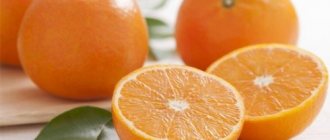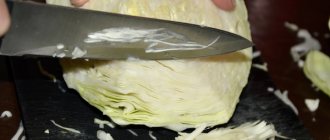Is it possible for pregnant and breastfeeding women?
Today, the opinions of experienced obstetricians and gynecologists who observe a woman during her pregnancy differ on the advisability of using sauerkraut. Some doctors believe that this product can provoke an increase in a woman’s arterial blood pressure, and in the later stages of gestation can cause such a terrible condition as eclampsia. Other experts believe that under medical supervision and in small dosages, cabbage is beneficial, not only for the mother, but also for her unborn child.
The fact is that sauerkraut sufficiently supplies a woman’s body with the iron she needs, especially in the last trimester of pregnancy. In addition, this vegetable is an excellent prevention of constipation and disorders of the digestive system, to which all pregnant women have an increased tendency. Dietary fiber of plant origin, which white cabbage is so rich in, improves the digestion and absorption of food, and also helps cleanse the body of waste and toxins naturally.
It has been noted that sauerkraut brine is an effective remedy for toxicosis in pregnant women. Taking this product reduces the feeling of nausea, helps reduce the number of vomiting, and in addition, replenishes the water-salt balance with persistent repeated vomiting.
Sauerkraut, due to its ability to remove excess fluid from the body, is not only one of the factors regulating arterial blood pressure, but also effectively helps to get rid of swelling of the face and lower extremities. In addition, cabbage juice and lactic acid in its composition are an effective preventative against the proliferation of bacterial microflora in the kidneys and urinary tract, which almost all pregnant women at different stages of pregnancy have a tendency to do.
Sauerkraut also benefits a developing baby in utero. It contains folic acid, which is responsible for the formation of the fetal neural tube, from which a full-fledged central nervous system will subsequently be formed. In addition, folic acid is a preventative against abnormal developmental defects in the unborn child.

In addition to folic acid, cabbage is rich in magnesium, which is also an important component in the formation of the baby’s organs and systems
Magnesium is a catalyst in the production of proteins, so it is indispensable for the creation of such an important building material at all stages of fetal formation. In addition, magnesium contributes to the normal exchange of nutrients between the placenta and the baby.
A lack of magnesium during pregnancy can result in heart or musculoskeletal defects for the fetus.
After the birth of a child, women begin the period of lactation
Sour cabbage requires careful use when breastfeeding. The fact is that in the first six months of a newborn’s life, the digestive tract is little adapted to full functioning, so if the mother eats cabbage, the child may experience painful intestinal colic and stool failure.

After the baby reaches 6 months of age, sauerkraut in small quantities during breastfeeding will be beneficial for the child’s body. It is believed that this product improves milk flow, increases its quantity and fat content
Cabbage, including sauerkraut, should be introduced into a nursing mother's diet carefully and only if neither she nor the child has allergic reactions to this product, and there are no digestive disorders or diarrhea.
For more information on the benefits of sauerkraut, watch the video below.
Is sauerkraut good for weight loss and pregnancy?
The unique properties of sauerkraut will also be useful in cases where it is necessary to provide the body with special, high-quality, but at the same time light nutrition. Nutritionists recommend including pure product and dishes made from it in the menu to all people who want to lose excess weight, as well as to expectant mothers.
When losing weight
If we exclude genetic predisposition and a number of diseases, a sedentary lifestyle and banal overeating are the main reasons for gaining excess weight. Simply put, the body receives more energy from food than it needs to maintain internal processes, as well as muscle and mental activity.
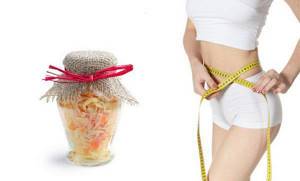
Sauerkraut is low in calories, rich in vitamins, but gives a feeling of fullness, so it is an ideal product for weight loss. It is easy to combine with different products, resulting in tasty and healthy dishes.
Cabbage is characterized by regulating, cleansing and stimulating intestinal function. Thanks to fiber and pectins, it takes a long time to digest and is easily excreted from the intestines. The constant feeling of hunger, which is known to everyone who has been on a diet, is absent. When using a menu with sauerkraut, not only a permanent weight loss is observed, but also a general improvement in the body’s health.
During pregnancy
Eating sauerkraut during pregnancy allows a woman to get rid of toxicosis, maintain normal hemoglobin levels, and not experience a lack of vitamins and minerals, which are so lacking during the cold season. As a side dish for meat and fish dishes, it promotes better absorption of protein by the mother's body. Regular use of the product helps improve the functioning of the gastrointestinal tract, avoid excess weight gain, and eliminate heartburn.
The presence of folic acid is essential for fetal development. Vitamin K, which is also present in sauerkraut, will help ensure blood clotting during childbirth. However, you should not get carried away with this product, which is certainly useful for pregnant women. Large portions can cause severe gas formation. It is better to eat it little by little, but regularly. The ideal recipe would be traditional sourdough.

Contraindications
Considering the huge range of beneficial properties of the vegetable, it is necessary to note the other side of the issue, namely, contraindications for consuming cabbage.
White cabbage is prohibited for consumption by people:
- with an increased level of gastric acidity;
- patients diagnosed with colitis and enteritis;
- children under 2 years of age.
Kohlrabi is not recommended for consumption by people who have:
- gout;
- stones in the kidneys;
- dysfunction of the thyroid gland.
Red cabbage should be eaten with caution:
- people prone to allergic reactions;
- having a predisposition to bloating and indigestion;
- pregnant women with individual intolerance (read more about whether you can eat cabbage during pregnancy here).
Brussels sprouts are a gourmet choice. It has a huge range of beneficial properties, however, despite this, it is contraindicated for people prone to:
- to upset stomach;
- with thyroid problems.
As for cauliflower and broccoli, despite their leadership, they can be harmful:
- patients with pancreatic system problems;
- people with diagnosed gastritis and high acidity;
- people with allergies;
- patients diagnosed with “weak intestinal tone.”
Benefits for weight loss
In most cases, for the purpose of losing weight, the product is used by women who want to lose some excess weight. Cabbage brine has cleansing and fat-breaking properties.
The benefits for weight loss are explained by the presence of a large amount of tartronic acid, which does not allow fat to accumulate in the body. Nutritionists assure that a positive effect can be achieved in fairly short periods of time if you regularly consume cabbage and lead a healthy lifestyle.
Homemade recipe
A lot of dishes are prepared from this culture. It has an excellent taste, both boiled and stewed, fried, as part of other vegetables, with meat, fish, etc. But for our readers we will present several recipes that will be useful in all cases.
So, while the meat is cooking, prepare the rest of the ingredients. For 6 liters of borscht we need:
- 5 medium-sized potatoes;
- 3 medium or 2 large onions;
- 1-2 sweet peppers;
- 1 large or 2 medium carrots;
- 2 medium or 1 large beets;
- Half a head of white cabbage;
- 3 tablespoons of tomato paste.
Sunflower oil, 50 grams of butter and 100 grams of vegetable oil, dill and parsley, 6-7 cloves of garlic, salt, ground black pepper to taste, bay leaf.
While the broth is cooking, let's start frying. Pour sunflower oil and a piece of butter into a large frying pan, fry the onion cut into half rings. Then add short straws of sweet pepper, fry, then grated carrots. After 3 minutes, grate the beets on a coarse grater, stirring constantly. When ready, add 3 tablespoons of tomato paste, mix thoroughly, fry and fill to the top with broth.
2.5 hours after cooking the meat, add bay leaves (3 pieces) and diced potatoes to the broth, and after 15 minutes, shredded cabbage. Cook for another 15 minutes and pour in the prepared vegetable gravy. Salt, pepper, squeeze out the garlic, sprinkle with chopped herbs 5 minutes before turning off. Let the borscht brew for about 1-2 hours and you can enjoy the amazing taste of the healthy dish. Serve with salted lard and sour cream.
First of all, you should lean on salads with cabbage, but season only with vegetable oil, lemon juice and low-fat yogurt without additives. Also, if you are losing weight, you should not add salt to the dish, add sugar, or add mayonnaise or sour cream. You can diversify the taste with seasonings such as coriander, cumin, mustard, chili pepper, etc.
The second irreplaceable cabbage dish for those who want to lose weight is soup, which can be eaten in unlimited quantities. At the same time, a complex of other vegetables and seasonings present in the first course will bring invaluable health benefits and provide vitamins. So, remember the recipe for cabbage soup for weight loss:
- 1 head of cabbage;
- 2 sweet green peppers;
- 7 tomatoes;
- 2 onions (medium);
- 1 carrot;
- medium bunch of greens (celery, dill, parsley).
The diet plan is to eat unlimited amounts of soup for a week; on the 3rd day of the diet, you can treat yourself to 200 grams of lean white fish or meat (brisket). On the final 7th day you need to cleanse yourself with boiled rice, the portion is also at the request of the person losing weight.
In addition to soup, during fasting days you can enjoy raw vegetables, fruits, kefir, and low-fat yogurt.
This scheme provides for 4 days, with its help you can lose up to 2 kilograms. But at the same time, the body receives powerful relief, toxins are cleansed, vigor and energy increase. And also a fermented product:
- improves metabolic processes;
- regulates fat metabolism;
- only 20 kcal per 100 grams of product;
- neutralizes the feeling of hunger for a long time;
- the body spends a lot of energy processing coarse fibers.
Diet plan:
- Breakfast: kefir or yogurt with slices of orange, tangerine, kiwi or mango. If desired, you can prepare a cocktail using these ingredients.
- Lunch: one thing - soup, salad, stew with rice, buckwheat or sauerkraut cutlets with beans.
- Dinner: vegetable salad, seasoned with vegetable (preferably olive) oil, apple cider vinegar or lemon juice.
You can make sauerkraut yourself at home. The cooking process is quite simple.
We will need:
- 1 kg. cabbage;
- 25 g salt.
Recipe outline:
- Chop the cabbage with a knife into a glass or metal enamel container. Add salt and stir.
- Compact the resulting mass with a wooden masher.
- Cover the mixture with a plate or any thick disk made of food material. Place a weight on top weighing about 4-6 kg. You can use a jar or bottle filled with water.
- Leave at room temperature for 5-7 days. Every 2 days it is necessary to open the product and pierce it with a wooden stick to release excess gas.
- Transfer the finished product into a glass container and store in the refrigerator.
How to make sauerkraut. Recipes
You can determine the benefits of preservation by taking into account the components in the composition. Cabbage is fermented separately or with the addition of carrots, cranberries, herbs (dill, parsley), beets, garlic, tomatoes, unsweetened apples, etc.
For the classic recipe you will need the following products:
- white cabbage (1 kg);
- salt (25-30 g);
- carrots (50 g).
The vegetables are rinsed and finely chopped, salt is added and mixed. The products are placed in an enamel pan or barrel, and pressure is placed on top. The container is placed in a cool place with a temperature of no more than +17...+20°C for 3 days. Every day you need to pierce the mass to eliminate gases. The finished products are transferred to sterilized jars and stored in the refrigerator.
To ferment cabbage in a jar you will need:
- white cabbage (2.5 kg);
- carrots (1 pc.);
- salt (2 tbsp);
- sugar (1 tsp);
- black peppercorns (12-15 pcs.);
- boiled water (1 l).
Vegetables are chopped, placed in an enamel bowl, and mixed with seasonings. The mixture is transferred to a jar. Then sugar and salt are dissolved in boiled water, the liquid is poured into a jar. The container is closed with a lid, placed in a metal basin and left overnight in a place at room temperature. For several days it is necessary to pierce the composition with a skewer to eliminate the formed gases. Then the jar is put in the refrigerator.
For the following recipe you will need:
- heads of cabbage (2 kg);
- cranberries (150 g);
- carrots (1 pc.);
- salt (4 tbsp);
- bay leaves (1 pc.);
- granulated sugar (2 tbsp.).
The cranberries are rinsed, the head of cabbage is chopped, and the carrots are grated. The components are mixed with the addition of salt and granulated sugar. Place 1/3 of the mixture into an enamel pan, compact it, add a bay leaf, and pour in 1/3 of the berries. Then several layers are repeated. Place a plate on top of the pan and apply pressure. The dishes are left in the kitchen for 5-6 days. After the foam appears, the mass is pierced with a wooden skewer. After reaching readiness, the products are moved to the refrigerator.
Compound
The finished product, after completion of the fermentation process, retains all its valuable biologically active substances, as well as vitamins and mineral complexes. This happens for the reason that the preparation of sauerkraut does not require heat treatment of raw materials. Lactic acid fermentation is carried out naturally under the influence of lactobacilli. Typically, white, juicy varieties are used to prepare cabbage. This product, prepared by fermentation, contains the following components per 100 grams:
- protein components – 1.7 g;
- fats – 0.2 g;
- carbohydrate components – 2.9 g;
- organic acids – 1.2 g;
- starchy compounds – 0.2 g;
- saccharides – 2.9 g;
- plant fibers – 2.1 g;
- water – 90 g;
- vitamin B1 (thiamine) – 0.03 mg;
- vitamin B2 (riboflavin) – 0.03 mg;
- vitamin C (ascorbic acid) – 32 mg;
- vitamin E (tocopherol) – 0.2 mg;
- vitamin PP – 0.7 mg;
- niacin – 0.45 mg;
- potassium – 305 mg;
- calcium – 47 mg;
- magnesium – 17 mg;
- sodium – 935 mg;
- phosphorus – 32 mg;
- iron – 0.7 mg.
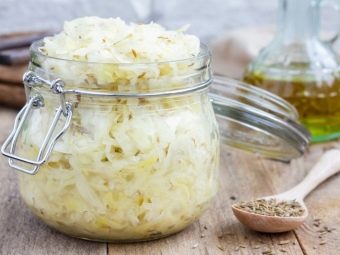
As we can see, judging by the chemical composition of sauerkraut, the product is most saturated with ascorbic acid, as well as potassium and sodium ions. The share of ascorbic acid is more than 33% of the total amount of all components, but the share of sodium is almost twice as large - 71.6%. Sodium ions are an essential component in the human body, which is necessary for the normal balance of water and salts, as well as for the transmission of nerve impulses in the central nervous system.
Thanks to sodium, our muscles are able to contract, and the heart does its job of supplying organs and tissues with oxygenated blood.
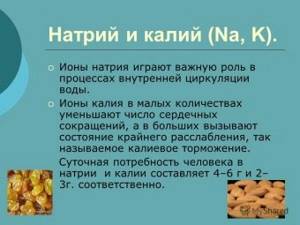
Calorie content and chemical composition
Sauerkraut is a product with a fairly low calorie content, so when consuming it, you don’t have to think about the serving size. The following data will be important for those who are accustomed to monitoring the energy and chemical components of dishes. 100 g of sauerkraut contains only 27 calories. Nutritional value is determined by the following indicators (contained in 100 g of product):
- proteins – 1.511 g;
- fat – 0.092 g;
- carbohydrates – 5.179 g.
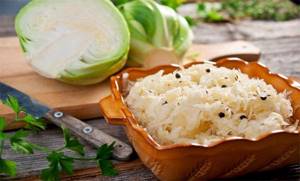
The rest comes from water, dietary fiber and ash. But sauerkraut is especially rich in vitamins, as well as macro- and microelements. It contains vitamins A, B, C, E, PP, K, U, but their quantitative indicator depends on the variety and shelf life of the vegetable, as well as the cooking time of the product. Cabbage fermented in the spring will contain less vitamins than cabbage prepared in the fall.
Among macroelements, cabbage is rich in potassium, phosphorus, calcium, sodium, chlorine and sulfur. Provides the body with the iodine, manganese, boron and iron it needs. Other microelements include copper, cobalt, nickel, and molybdenum. There is also chromium, fluorine, lithium, vanadium, rubidium.
Among the useful substances, it is worth highlighting organic acids - malic, folic, tartronic, acetic and lactic. Fiber and pectins, although not digested by the body, are nevertheless necessary for the quality functioning of the gastrointestinal tract.
Consumption of various parts of the plant:
Cabbage is a nutrient-rich vegetable. All parts of the fruit are marked as edible (leaves, heads of cabbage, stalks and even its juice). Eating every component of cabbage in any form is good for health.
Kochan
Actually, it is the head of cabbage that is eaten. If we talk about white and red cabbage, then their early varieties have the most tender leaves, are poorly stored, but are very tasty fresh. Medium-ripening cabbage lends itself well to processing and is successfully used for cooking. Well, late varieties are ideal for long-term storage and pickling.
It is worth noting that with proper storage, cabbage heads do not lose their taste and beneficial properties until mid-winter and longer.
In other types of cabbage, the heads of cabbage may look different, but the essence does not change.
Kocheryzhka
Cabbage stalks are a delicacy of early childhood. But there is debate about its usefulness. On the one hand, it is a storehouse of fruit nutrients. On the other hand, harmful substances, nitrates, fertilizers, etc. can accumulate in it. Knowledgeable people claim that it is very easy to recognize harmful cabbage by cutting the stalk. It will not be pure white, but with dark or pinkish spots.
The stalk is often used in folk medicine to prepare a decoction, the purpose of which is to fight cancer cells. To prepare folk medicine you will need:
- finely chopped stalk;
- sunflower oil;
- Tatar leaves;
- boiling water.
The decoction from the stalk must be wrapped and allowed to brew for more than 2 hours, after which the liquid should be strained and taken.
Leaves
The health benefits of cabbage leaves can be seen in practice, for example, by applying compresses to a sore spot. The action plan is as follows:
- Apply a fresh cabbage leaf to the sore spot;
- biologically active components of cabbage penetrate into tissues;
- Having reached it, they relieve pain and inflammation.
Compresses can be applied:
- for headaches on the occipital and frontal parts;
- on the cheeks for diseases of the oral cavity and external swelling;
- on the front of the neck for respiratory diseases: laryngitis, tonsillitis, inflammation of the lymph nodes;
- on the back of the neck for complex treatment of cervical neuritis;
- on the chest for diseases of the cardiovascular system, lungs, bronchi;
- on the abdominal cavity and pelvic area for diseases: prostatitis, cystitis, ovaries, liver, pancreas.
It is easy to determine the effectiveness of treatment with compresses; as soon as the BACs reach the site of inflammation and pain, the cabbage acquires a specific smell.
Juice
Benefits of taking fresh cabbage juice orally:
- helps the immune system resist diseases;
- prevents premature cell aging;
- improves blood clotting;
- forms bone tissue;
- promotes rapid treatment of respiratory diseases;
- stabilizes kidney function.
We invite you to watch a video about the benefits of cabbage juice:
May reduce the risk of certain types of cancer.
Cabbage, the main ingredient in sauerkraut, contains antioxidants and other beneficial plant compounds that may help reduce the risk of certain types of cancer.
Researchers believe these compounds may help reduce DNA damage, prevent cell mutations, and block excessive cell growth that typically leads to tumor development.
The fermentation process of cabbage can also produce certain plant compounds that inhibit the growth of precancerous cells.
Two recent studies suggest that cabbage and sauerkraut juice may help reduce cancer risk by reducing the expression of cancer-related genes.
Sauerkraut contains beneficial plant compounds that may reduce the risk of cancer cells developing and spreading.

The benefits and harms of sauerkraut
Sauerkraut contains many useful elements that are vital for our body:
- Vitamins A, groups B, E, C (“responsible” for vascular health, liver function, improves iron absorption, helps hematopoiesis processes and strengthens the immune system), H, P (strengthens capillaries, saturates tissues with oxygen and reduces the body’s response to action foreign bodies), U (protects the gastric mucosa) and K;
- Minerals - F (phosphorus), Na (sodium), S (sulfur), Cl (chlorine), Zn (zinc), I (iodine), Cu (copper), Cr (chromium) and Mo (molybdenum), Ca (calcium ), K (potassium), Mg (magnesium) and Fe (iron);
- The dish is rich in complex carbohydrates - starch, pectin, fiber and organic acids. All of them promote good digestion, remove waste products, regulate metabolism and prevent cancer.
This rich composition gives sauerkraut its benefits and many medicinal properties:
- For the digestive system - increasing appetite, enhancing intestinal function, normalizing microflora and acting as a mild laxative effect. For example, brine treats gastritis with low acidity, has a stimulating effect on bile secretion, and is also used to relieve constipation and hemorrhoids.
- For the cardiovascular system, the fiber in the composition is able to absorb cholesterol, preventing it from penetrating into the blood; removes bile acids from the body, preventing the development of atherosclerosis and ischemia.
- For diabetes mellitus type 1 and 2, since it contains no sucrose (if you do not add sugar during preparation) and few simple carbohydrates. Enriching cabbage with lactic acid and enzymes ensures fermentation, which improves the activity of the pancreas, which is reduced in this disease. Symptoms of neuropathy are relieved due to the presence of B vitamins in cabbage. Diabetes mellitus often causes problems with excess weight, which the snack also helps to get rid of.
- The vitamin and mineral composition, as well as antioxidants in sauerkraut, help the body resist viruses and infections during cold weather. But even if you have already caught a cold, cabbage brine will relieve a sore throat, cough and high fever. To do this, you just need to dilute it with boiled water and drink or gargle.
- For the central nervous system - the B group of vitamins has a positive effect on the transmission of nerve impulses, the functioning of the central nervous system and the peripheral nervous system, increasing resistance to stress. A lack of these elements makes a person irritable, impairs sleep, causes headaches and contributes to rapid fatigue, which leads to neuropsychiatric disorders.
The benefits of sauerkraut also extend to women, helping to maintain youth and beauty, eliminating some problems in appearance - lotions and masks eliminate acne, age spots, freckles and oily porous skin.
About contraindications and dangers of sauerkraut
Despite the general recognition by doctors and nutritionists of the health benefits of sauerkraut, it still has some contraindications. Organic acids and salt in the composition prohibit the consumption of snacks for the following health problems:
- People with high acidity of gastric juice.
- When there comes a period of exacerbation of gastritis and stomach ulcers.
- If increased gas formation is observed.
- For hypertension and pancreatitis.
- If edema is diagnosed due to heart disease.
- Renal failure and other kidney diseases, for which a salt-free diet is indicated.
- Gallstones.
The snack also has some other properties that have a negative effect on the body - it stimulates the appetite, which is not very necessary for people who are overweight, and salt leads to fluid retention + fermentation processes stimulate severe gas formation.
When consuming sauerkraut, always focus on how you feel. To soften the effect, you can simply remove excess juice and add vegetable oil, which will help the body tolerate the dish without unpleasant side effects.
Another important point is to keep it in moderation and not overeat, and then the pleasant impression of a tasty product will not be overshadowed by anything.
How cabbage helps you lose weight
Sauerkraut is produced by lactic acid fermentation. When systematically added to the diet, the product can keep weight under control. Among the beneficial properties are the following:
- Low energy value.
The main advantage of cabbage is its low calorie content. Only 18 kcal per 100 g.
- Slow absorption of fats.
The product contains a large number of probiotics. Lactobacilli inhibit hydrolysis, which leads to decreased fat absorption. At the same time, the excretion of fatty compounds during bowel movements is enhanced. As a result, chronic inflammation is suppressed, metabolism is accelerated and the general condition of the body improves.
- Strong feeling of fullness.
Cabbage contains a large amount of fiber. When dietary fiber enters the stomach, it absorbs a lot of moisture, thereby increasing in volume. A person feels full, and the craving for food is dramatically reduced. It has been scientifically proven that the mechanism is reflexive in nature.
Many studies have been conducted around the world on the effect of sauerkraut on the body. All of them showed positive results. The product is truly effective in the fight against excess weight, regardless of the person’s gender.
Important ! Cabbage contains a lot of fiber and virtually no fat. It contains vitamins B, A, C, E, H, PP and trace elements zinc, selenium, magnesium, potassium and iron.
In addition, the product has anti-inflammatory, antibacterial, diuretic and choleretic effects. Increases endurance and performance. In general, it quickly restores the body and strengthens the nervous system. Relevant for people engaged in heavy physical or mental labor.
What does cabbage cure?
How to treat gastritis with cabbage?
One of the most proven methods is to treat gastritis with cabbage juice. Most people underestimate this vegetable, but in vain. After all, white cabbage is a real chest of vitamins. In particular, it contains a unique vitamin U (methylmethionine), especially necessary for a person with gastritis or ulcers, as well as PP, which tidies up the functioning of the gastrointestinal tract.
We can say that cabbage juice is considered somewhat exotic, and sauerkraut is a completely familiar dish, which, however, should not be consumed during the phase of exacerbation of the disease. And in the subsiding phase of the disease, sauerkraut for gastritis contributes to:
- improving motor skills;
- eliminating constipation;
- improving microflora in the intestines;
- increasing immunity;
- eliminating inflammation in the mucous membrane.
And sauerkraut for gastritis with high acidity can be consumed limitedly, but only during the period of subsidence of the disease. It is best to abandon it in this form when the acid level increases, so as not to cause complications of gastritis and stomach ulcers.
The main product in the treatment of this disease (especially when the acidity level decreases) can be stewed cabbage. During stewing of vegetables, useful elements are preserved, which help improve the functioning of the digestive tract and reduce the load on the stomach tissue. Stewed cabbage for gastritis has the following effects:
- eliminates inflammation of the mucous membrane;
- accelerates regenerative processes;
- improves digestion;
- perfectly satisfies hunger while following a strict diet;
- reduces pain.
How to eat cabbage with pancreatitis?
White cabbage in the acute phase of pancreatitis:
The inflamed pancreas quickly and violently reacts to any dietary deviations with painful attacks, increased vomiting, profuse diarrhea, renewed fever, bloating and some other serious symptoms. Dishes with white cabbage can provoke or intensify all these unpleasant signs of an acute process in the pancreas. This negative impact is due to the content in it:
- Essential oils (it is their presence that explains the pungent taste of raw cabbage);
- Coarse fiber (fibers are visible even to the naked eye in cabbage), the amount of which is 2 g per 100 g of product.
White cabbage in remission phase:
After inflammation subsides or completely resolves, the diet of patients with pancreatitis expands significantly. The introduction of white cabbage begins with its inclusion in vegetable soups. If the patient does not experience any adverse changes in well-being after such a lunch, then other boiled, stewed and baked dishes with cabbage (casseroles, cabbage rolls, stews, cutlets, rolls, etc.) are added to the menu. If you maintain a stable, satisfactory state of health, then include fresh and non-acidic sauerkraut in your diet
However, in this form it can serve as an impetus for a new exacerbation, so it should be eaten very carefully and in limited quantities.
Dietary recommendations for patients with pancreatogenic diabetes (caused by pancreatitis) are no different in this case. After all, white cabbage contains little sucrose and starch, so it changes blood sugar levels little.
The benefits of cabbage for men and women
Of course, most lovers of the presented pickles are wondering how sauerkraut is useful for women and men .
Surprisingly, the stronger half of humanity and the fair sex can solve some spicy problems with the help of daily or regular consumption of the dish.

Benefits for men
What are the benefits of sauerkraut for men ? It turns out that this unique and tasty product has a positive effect on male potency.
So, with the help of daily consumption of pickles, you can prevent the development of prostate diseases.
Experts also recommend that older men do not neglect the use of sauerkraut, since it significantly increases potency, which allows you to get rid of sexual problems.
Many men have experienced the effect of the product and compare it to a natural aphrodisiac.
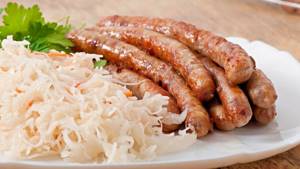
Benefits for women
Sauerkraut for women is the best dish for rejuvenating the skin and body, as well as for losing weight and preventing weight gain, as mentioned above.
Women often use the presented product as a natural cosmetic product in the form of face masks, and also arrange fasting days for themselves in order to maintain their slim figure.
As for other representatives of the fair sex, sauerkraut during pregnancy helps to cope with nausea during toxicosis.
But during long periods of pregnancy, its use should be avoided, since the salt content affects fluid retention in the body, and excess accumulated water will only harm the health of the mother and baby.
Fans of the presented pickles are wondering whether a nursing mother can have sauerkraut ? Here, obstetricians advise limiting such dishes.
A fresh vegetable may not harm the baby’s intestines, but the pickled version quite often leads to gas formation and colic in the child.
This is often due to spices and vinegar added to cabbage, which causes bloating in both mother and baby.
How to use - 4 rules

Sauerkraut is included in the diet from 3-4 years of age until old age. It is consumed as an independent snack and as a side dish for meat products, first and second courses are made on its basis, and the brine is drunk in small portions.
The best form for absorption by the body is a salad with onions and vegetable oil. In this form, the dish better copes with the task of enriching the intestinal microflora, cleanses the gastrointestinal tract more effectively, and contains the maximum amount of beneficial bacteria.
If you eat sauerkraut as a main or additional side dish for meat dishes, it will prevent the intestinal walls from absorbing lipids. As a result, the body will receive only the building material for muscles - protein, and not harmful, hard-to-digest fats that settle on the stomach and sides.
To obtain the correct product when fermenting, follow these recommendations:
- The dishes used are enameled, without chips and cracks, or wooden, well cleaned, washed and dried.
- The heads of cabbage are taken tight, healthy, without signs of mold or rot.
- Cabbage is chopped coarsely, since a heavily chopped vegetable loses some of its nutrients.
- Use a minimum of salt and do not add vinegar.
- The best way to preserve it is by grinding it with salt until you get juice.
- To increase the value of the dish, add carrots, cranberries, and lingonberries.
- The chopped vegetables are placed in a bowl for fermentation, covered with a wooden board, a weight (4-5 kg) is placed on top and left warm.
- Every day, a long wooden skewer is used to pierce the appetizer to the bottom, facilitating the release of carbon dioxide. It prevents mold fungi from multiplying.
- Ferment the dish for at least 2 weeks. Afterwards they are put into the refrigerator or cellar.
- Store for no more than 10 months.

Sauerkraut has a positive effect on brain activity: improves memory, reduces symptoms of depression and anxiety. However, it should not be eaten while taking antidepressants: this increases the risk of a severe hypertensive crisis, since monoamine oxidase inhibitors (MAO) are incompatible with the tyramine contained in the fermented vegetable.
Below are basic tips for consuming sauerkraut that will help you achieve maximum effect:
Consider the amount of salt. 100 g of sauerkraut contains half the daily requirement of table salt. Excessive salt consumption can lead to the development of edema and increased blood pressure. Therefore, do not eat more than 100-150 grams of cabbage per day. You should also not drink sauerkraut juice (pickle) due to its high salt content. Eat cabbage between meals (as a snack). It has extremely low energy value and quickly makes the body feel full, so during the main meal you will eat less. You are allowed to reheat the dish before eating (40 seconds in the microwave). Add it to lunch and dinner. Cabbage goes perfectly with any protein products, especially chicken breast and other dietary meats. It will additionally enrich the body with fiber, which is extremely important for losing weight, maintaining intestinal microflora and overall health.
It is also important to take into account that pickled cabbage cannot be combined with any fatty foods; neglecting this rule can lead to the appearance of dyspeptic disorders (flatulence). Due to its low calorie content, sauerkraut can be eaten in the evening for dinner, or even at night.
Drink more water. You should additionally take about 600 ml of liquid for every 100 g of sauerkraut per day. This will remove excess salt from the body and increase the amount of cabbage that can be eaten per day to 240 g per day.
Despite all the value of this product, there is still a group of people who will only be harmed by it. For example, contraindications for use are:
- chronic diseases of the stomach and duodenum;
- inflammation of the pancreas;
- renal failure;
- gallstones.
These contraindications are due to the content of a significant amount of acids in sauerkraut.
There is an opinion that abuse of this product by men threatens them with a decrease in potency.
Scope of application
Due to its taste and medicinal properties, sauerkraut began to be used not only in cooking, but also in folk medicine, cosmetology, and dietetics.

In folk medicine
Very often, sauerkraut and brine are used for medicinal purposes, for various diseases, not forgetting their contraindications:
- the juice is used in the form of lotions to heal burns, wounds on the skin due to diathesis in children, and to treat lichen;
- hair masks are made to get rid of lice;
- Brine is good for hemorrhoids and constipation;
- serves as a prevention for the development of stomach ulcers;
- normalizes microflora, improves peristalsis, which is good for intestinal function;
- recommended for cardiovascular diseases;
- The juice is recommended to be taken to prevent atherosclerosis;
- juice diluted with boiled water helps relieve sore throat and treats sore throat;
- the juice relieves bleeding gums;
- juice is used to prevent viral and bacterial infections;
- can be taken for type 1 and type 2 diabetes mellitus, but only if sugar was not used in its fermentation;
- brine replenishes fluid loss at high body temperatures;
- applying fermented leaves to the forehead relieves headaches;
- compresses from the leaves relieve inflammation of the mammary gland due to mastitis;
- for psoriasis and psoriatic polyarthritis, it is necessary to lubricate the affected areas of the skin with brine before going to bed;
- Regular consumption of sauerkraut helps relieve inflammation in the joints;
- for diarrhea, you need to drink 1-2 glasses of brine half mixed with tomato juice during the day.
Important! When taking sauerkraut juice for medicinal purposes, you must ensure
that it does not contain spices.
In cooking
In addition to the fact that sauerkraut brings tasty benefits, it is also widely used for preparing first courses, you can make salads and snacks from it, it serves as a filling for dumplings, pies, and acts as a side dish for meat and fish dishes.
In cosmetology
This product is also used as a cosmetic product:
- sauerkraut masks cleanse facial skin and tighten pores;
- nicotinic acid, which is part of the dish, gives shine to hair and strengthens nails;
- hair mask strengthens roots and prevents baldness;
- use juice to remove freckles and age spots;
- finely chopped sauerkraut is used instead of peeling.

For weight loss
Sauerkraut plays an important role for those who are on a diet or counting how many calories are contained in this product.
She has the following qualities:
- does not contain many calories;
- improves metabolism;
- gives a feeling of satiety;
- enhances intestinal motility;
- prevents the conversion of carbohydrates into fats;
- refers to products with negative calorie content;
- It alkalizes, but does not acidify the body.
How much is digested in the stomach?
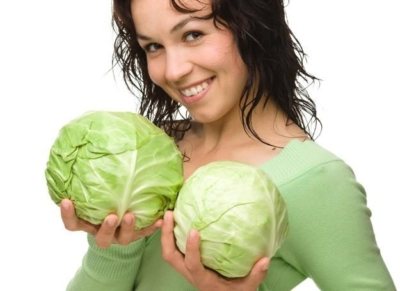
In order for food to benefit a person and provide the necessary energy, it must be converted into chemical elements that are absorbed by our body:
- From the esophagus, food first enters the stomach, then into the intestines, where it continues to interact with gastric juice.
- The processed substances are then absorbed through the capillaries into the blood, which passes through the liver.
- Liver enzymes neutralize toxins while preserving beneficial microelements, vitamins and glucose.
Attention!
It usually takes 3 hours for the body to digest fresh cabbage, and 4 hours to process sauerkraut.
We can talk about the usefulness of this product for a very long time. But in addition to all the listed properties, fresh cabbage is, first of all, a tasty vegetable that can decorate both everyday and holiday tables.
But, like any product, cabbage should be eaten in moderation, and before consuming, be sure to read all the contraindications. And then this product will bring maximum benefit.
Vitamins in sauerkraut
Sauerkraut contains a whole complex of vitamins. When consumed, 100 g of this product enters the gastrointestinal tract:
- retinol equivalent (A) – 598.744 mcg;
- thiamine (B1) – 0.027 mg;
- riboflavin (B2) – 0.038 mg;
- pantothenate (B5) – 0.179 mg;
- pyridoxine (B6) – 0.074 mg;
- folate (B9) – 8.816 mcg;
- ascorbic acid (C) – 38.064 mg;
- alpha-tocopherol, tocopherol equivalent (E) – 0.166 mg;
- nicotinic acid (PP) – 0.966 mg.
Sauerkraut also contains biotin - vitamin B7 or H. The concentration of this compound is 0.094 mcg per 100 g of product.
Medicinal properties of sauerkraut
The abundance of beneficial properties, vitamins and minerals makes sauerkraut an indispensable ingredient in traditional medicine. It is used in recipes for various diseases:
- diabetes mellitus,
- hypotension,
- constipation,
- gastrointestinal diseases,
- cardiovascular diseases.
Sauerkraut also helps to relieve internal inflammation, it normalizes the activity of the gastrointestinal tract and helps normalize the digestion process.
Use for diabetes
Due to the high content and almost complete absence of sucrose and starch, sauerkraut will be an excellent addition to the menu for diabetics. Moreover, due to its ability to remove sugar and toxins from the body, it is recommended for frequent use.
And thanks to the presence of alkaline salts, glucose is converted into fructose. Thus, the body can absorb fructose without the participation of insulin.
In turn, cabbage brine normalizes the functioning of the pancreas and stimulates the functioning of the intestines. In addition, vitamins B and C strengthen the immune system and prevent the development of nervous diseases.
For hypertension and hypotension
Eating sauerkraut for hypertension is not recommended. This is due to the fact that this product contains a large amount of salt.
Salt retains fluid in the body, which in turn increases blood volume and leads to increased blood pressure, which can provoke a hypertensive crisis.
Thus, in case of hypertension, cabbage prepared by sauerkraut should be excluded from the diet, or the product should be thoroughly rinsed to remove salt.
In turn, eating sauerkraut is acceptable for hypotension. Due to its properties that increase blood pressure, it strengthens the cardiovascular system and has tonic properties.
For gastrointestinal diseases
Sauerkraut helps improve microflora in the intestines, eliminate inflammation in the mucous membranes and eliminate constipation and improve digestion. However, despite all these properties, the use of this product is contraindicated for certain pathologies of the gastrointestinal tract.
If the symptoms of the disease decrease, sauerkraut will be an excellent addition to the diet. It works well as a prophylactic against gastritis, helps improve appetite and the production of gastric juice, microflora in the intestines, and eliminate inflammation of the mucous membrane.
Basic rules for losing weight with sauerkraut
If you intend to lose weight using sauerkraut, follow these rules:
- do not go on a cabbage diet for more than 3-7 days;
- combine the diet with light physical activity - cycling, walking, etc.;
- do not deny yourself snacks with permitted foods;
- drink at least 2 liters of water per day;
- breaks between meals should be no more than 4-5 hours.
Remember that sauerkraut should not be taken at night when losing weight.



